1) Knowledge will help you tackle your own water pump system installation and maintenance. Doing work for yourself is always rewarding.
2) With your knowledge you can be ready for action rather than wait for a plumber or hope to find a good plumber.
3) Peace of mind occurs when you understand how pump works. It is not some impossible unknown mechanism that only trained plumbers can handle.
4) You can better protect your home and help others protect theirs.
If you have no knowledge, consider reading more detailed information about each type, the primary submersible, battery backup and water powered. Videos are also a great way to visualize how sump pumps work. View them for the primary submersible, battery backup and water powered pump.
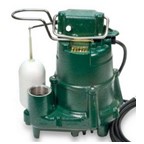
Here are the three basic parts of a sump-pump. Basically they all contain the same three parts with variations based on brand and model.
The first part is the float switch which triggers the motor to run when the water reaches a certain level; the second part is the motor which turns on when the switch is activated causing the third part, the impeller to swirl and push the water up the piping system. Of course this is the bare minimum of sump pump how to. More details are available for the float switch, motor with its power measured in horse power and gpm (gallons pumped per minute), and the impeller with its various designs.
Write it down and place it where you can find it easily. We wrote our brand and model on a piece of masking tape and placed it on the wall next to the water pump.
If you are, buy another one just like it. Having a replacement makes sense, especially if your primary pump runs a lot. Eventually it will fail and the model you like may not be available when you need it.
If you are not happy with it, check out all of the information we provide. If you want to buy a water pump that is known as a best seller and highly rated we have a water pump list to help you. If you prefer to check several brands and models we have reviews on over eight brands with their various models. See the menu at the top of the page. Decide which is best for your water pumping needs and get it so you have less to deal with when a failure occurs.
If you are unsure about your current sump-pump size, check our size calculation guide. It provides a test to estimate how much water is pumped from your basin during heavy rainstorms.

Replacement switches are easy to find and easy to replace. We provide parts including switches for major brands. Replacement switches are rarely available for thermoplastic sump pumps. If the housing is cast iron, the motor and body will last much longer than the switch. Therefore, have a replacement switch on hand. The most likely time for a switch to fail is during a heavy rainstorm because it is working hard. Why have a major water event when you can have a spare part ready to replace the failed one? Here are available parts for many brands.
Since Big Box store sump pump float switch failures are due to the float sticking in the on position, it may be smart to install a water alarm to let you know immediately when the failure occurs so you can pull the motor plug. Basement Watchdogs water alarm is around $12. A very inexpensive investment compared to the cost of a new water pump.
It is challenging to remove the pump from the pit during a heavy rainstorm; therefore we are suggesting a better solution, an electronic switch. We installed the best sump pump switch in 2011 and have had no failures. It runs like a charm. We will never go back to the old switch type. The HC6000 attaches to the PVC pipe, has no moving parts, is not affected by water minerals, does not require removal of the pump to install, and it allows us to set the on and off point plus it has a lifetime warranty. Check Amazon; it is very highly rated. You can also read our lengthy HC6000 switch review.

If water is dripping down the side of the PVC pipe under the check valve or water is running back to the sump basin through the check valve after the motor stops, the check valve is either broken or something is caught in the flapper or disk preventing it from closing. If something is lodged in the flapper, remove the check valve from the PVC pipe and clean it.
Traditional check valves do not have as long of a lifespan as the quiet check valves, usually two years at most if the motor runs a lot.
If the pump makes a water hammer sound when stopping and the noise is bothersome, you may want to read more about the quiet check valve.
They definitely are quieter because of the spring gate; a clear one lets you see if the spring gate is operating properly. Learn how they work, why they quiet, and brand availability.
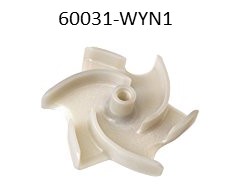
If debris and small pebbles collect in the sump basin it is essential to clean the bottom of the basin. Those objects can cause failure.
Different brands use different non-clogging techniques. Zoeller and Liberty Pumps use a vortex impeller which pass one-half inch to three-fourths inch spherical solids. Wayne uses top suction on most of their pumps. Basement Watchdog, Flotec and Simer use a bottom screen which can clog and therefore must be cleaned periodically.
To prevent air lock, a small hole should be found in the vertical discharge pipe close to the pump port. If the sump basin water is not clean, this hole can get plugged and cause air to interfere with water removal from the pit. It is advised to clean it periodically.
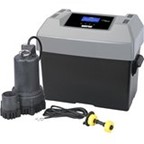
If your sump pump system does not include a backup sump pump, it is highly recommended one be installed. Sooner or later the electricity will fail during a heavy rainstorm or your primary pump will fail because of float switch issues. Flooding in the basement can cause mold which is very hard and expensive to remove plus it takes a lot of work time to remove.
The most common type of backup sump pump is battery operated. These work great if your electricity rarely fails, you have replacement parts on hand for your primary pump and you do not mind checking the battery for level of charge every few months.
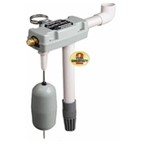
The water powered sump pump is becoming more popular these past few years. There is no battery to contend with. The only requirements are city water must be used and the water pressure must be strong enough to cause the water to be sucked from the pit at a reasonable gallon per minute rate. Only three manufacturers offer water powered pumps: Liberty Pumps, Base Products and Zoeller. Read more about the water powered sump pumps and also watch videos.
Be aware that most eighteen inch diameter basins taper at the bottom which leaves around sixteen and one-half inches for both a primary and backup pump to fit.
Some brands like Zoeller allow the backup pump to be installed in the discharge pipe above the primary pump which alleviates the width problem.
If the replacement is the same brand and model it is easy to replace. If you have never installed a pump before and would like to try, we recommend you try it when there is no rain in the forecast and you know a friend or plumber who can come to your rescue if you have problems.
1. Unplug the motor cord from the electrical current. Keep it away from the water.
2. Have a five gallon pail ready to catch the water remaining in the discharge pipe above the check valve.
3. Learn what kind of connectors the check valve has. If you need a guide, here is a list and pictures for the various connector types.

4. Remove the bottom connector.
5. Remove the top connector and catch the water.
6. Wiggle the discharge pipe loose.
7. Note how the pump is aligned in the pit. Remove the primary pump with the bottom part of the discharge pipe in the pump port.
8. Take a good look at the port. Look for the weep hole, clean it.
9. Observe the float. Identify what kind it is. Here are some pictures to help you.
10. Note the covered cap area above the float. This is the switch case.
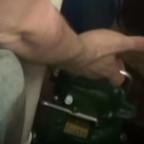
11. Put the primary pump back into the pit. Make sure it is aligned as it was before removing from the basin. It should be aligned under the top discharge pipe for re connection.
12. Attach the bottom of the check valve to the bottom discharge pipe attached to the pump in the pit.
13. Attach the top part of the check valve.
14. Plug in the pump cord.
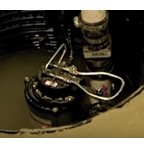
15. Put water in the pit to test the pump.
16. If you have a finished basement, make sure you have enough sump pump support.
Our basement is finished. We have decided it is more cost effective to install additional sump pump support than go through the frustration and loss of personal items. We have two sump basins; one is a sister connected to the main pit by a four inch pipe which gets overflow from the main pit. In each pit we have two sump pumps. The main pit has a primary and battery backup. The sister pit has two primary pumps. One is plugged into a Sumpro battery inverter which converts DC to AC allowing the usage of a primary pump to run if the electricity fails. Each of the primary pumps uses the HC6000 electronic switch for switch reliability.
We live in an area with a high water level table so our primary submersible runs every day even when the sun is shining. When it rains our pumps get a work out.
Before installing our system as described above we would worry when we were not at home and during heavy rainstorms would sleep in the basement ready to bail out the basin if the pump should fail. Now we sleep soundly and leave the home in confidence regardless of the weather forecast.
We hope you have learned a lot about your own sump pump system and are better prepared to care for your system in a proactive manner. Knowledge is powerful and provides peace of mind. The next time those heavy rainstorms come and you have problems you will be glad you have some idea of how to care for your sump pump system.
Let us know how the above information has helped you. We find it rewarding to know we have helped others.
Further increase your knowledge about sump-pumps, learn more about each type.
THE HELPFUL PUMP PLACE where you can become an educated shopper. Review - Compare - Shop for the Best Water Pump For Your Water Pumping Needs.